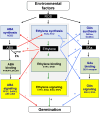Ethylene, a Signaling Compound Involved in Seed Germination and Dormancy
- PMID: 39409543
- PMCID: PMC11478528
- DOI: 10.3390/plants13192674
Ethylene, a Signaling Compound Involved in Seed Germination and Dormancy
Abstract
The present review is focused on current findings on the involvement of ethylene in seed biology. The responsiveness of seeds to ethylene depends on the species and the dormancy status, improving concentrations ranging from 0.1 to 200 μL L-1. The signaling pathway of ethylene starts with its binding to five membrane-anchored receptors, which results in the deactivation of Constitutive Triple Response 1 (CTR1, a protein kinase) that does not exert its inhibitory effect on Ethylene Insensitive 2 (EIN2) by phosphorylating its cytosolic C-terminal domain. An analysis of germination in the presence of inhibitors of ethylene synthesis or action, and using seeds from mutant lines altered in terms of the genes involved in ethylene synthesis (acs) and the signaling pathway (etr1, ein2, ein4, ctr1 and erf1), demonstrates the involvement of ethylene in the regulation of seed dormancy. The promoting effect of ethylene is also regulated through crosstalk with abscisic acid (ABA) and gibberellins (GAs), essential hormones involved in seed germination and dormancy, and Reactive Oxygen Species (ROS). Using a mutant of the proteolytic N-degron pathway, Proteolysis (PRT6), the Ethylene Response Factors (ERFs) from group VII (HRE1, HRE2, RAP 2.2, RAP2.3 and RAP 2.12) have also been identified as being involved in seed insensitivity to ethylene. This review highlights the key roles of EIN2 and EIN3 in the ethylene signaling pathway and in interactions with different hormones and discusses the responsiveness of seeds to ethylene, depending on the species and the dormancy status.
Keywords: crosstalk between ethylene, ABA, Gas and ROS; ethylene; ethylene response factors (ERFs); ethylene signaling pathway; proteolytic N-degron pathway; seed germination and dormancy.
Conflict of interest statement
The author declares no conflicts of interest.
Figures




Similar articles
-
Role of ethylene and proteolytic N-degron pathway in the regulation of Arabidopsis seed dormancy.J Integr Plant Biol. 2021 Dec;63(12):2110-2122. doi: 10.1111/jipb.13173. Epub 2021 Nov 2. J Integr Plant Biol. 2021. PMID: 34542217
-
Ethylene, a key factor in the regulation of seed dormancy.Front Plant Sci. 2014 Oct 10;5:539. doi: 10.3389/fpls.2014.00539. eCollection 2014. Front Plant Sci. 2014. PMID: 25346747 Free PMC article. Review.
-
Label-Free Quantitative Proteomics Reveal the Involvement of PRT6 in Arabidopsis thaliana Seed Responsiveness to Ethylene.Int J Mol Sci. 2022 Aug 19;23(16):9352. doi: 10.3390/ijms23169352. Int J Mol Sci. 2022. PMID: 36012613 Free PMC article.
-
Revisiting the Role of Ethylene and N-End Rule Pathway on Chilling-Induced Dormancy Release in Arabidopsis Seeds.Int J Mol Sci. 2018 Nov 13;19(11):3577. doi: 10.3390/ijms19113577. Int J Mol Sci. 2018. PMID: 30428533 Free PMC article.
-
Updated role of ABA in seed maturation, dormancy, and germination.J Adv Res. 2021 Mar 31;35:199-214. doi: 10.1016/j.jare.2021.03.011. eCollection 2022 Jan. J Adv Res. 2021. PMID: 35003801 Free PMC article. Review.
References
-
- Lelièvre J.M., Latché A., Jones B., Bouzayen M., Pech J.C. Ethylene and fruit ripening. Physiol. Plant. 1997;101:727–739. doi: 10.1111/j.1399-3054.1997.tb01057.x. - DOI
-
- Pech J.C., Bouzayen M., Latché A. Maturation des fruits. In: Albagnac G., Varoquaux P., Montigaud J.-C., editors. Technologies de Transformation des Fruits. Editions TEC & DOC, Lavoisier; Paris, France: London, UK: New York, NY, USA: 2002. pp. 79–102.
-
- Watkins C.B. Ethylene synthesis, mode of action, consequences and control. In: Knee M., editor. Fruit Quality and Its Biological Basis. Sheffield Academic Press Ltd.; Sheffield, UK: 2002. pp. 180–224.
-
- Abeles F.B., Morgan P.W., Saltveit M.E., Jr. Ethylene in Plant Biology. Academic Press; San Diego, CA, USA: 1992.
Publication types
LinkOut - more resources
Full Text Sources
Research Materials

